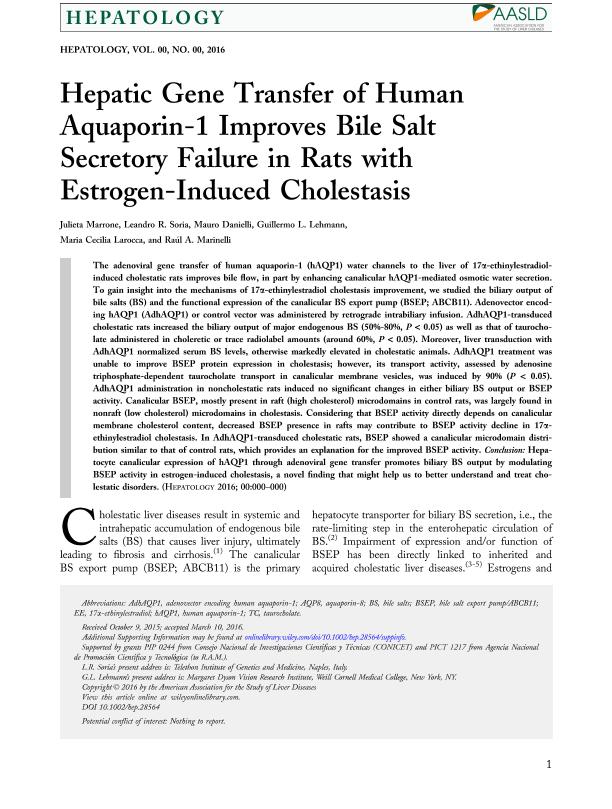Artículo
Hepatic gene transfer of human aquaporin-1 improves bile salt secretory failure in rats with estrogen-induced cholestasis
Marrone, Julieta ; Soria, Leandro Raul
; Soria, Leandro Raul ; Danielli, Mauro
; Danielli, Mauro ; Lehmann Mantaras, Guillermo Luis
; Lehmann Mantaras, Guillermo Luis ; Larocca, Maria Cecilia
; Larocca, Maria Cecilia ; Marinelli, Raul Alberto
; Marinelli, Raul Alberto
 ; Soria, Leandro Raul
; Soria, Leandro Raul ; Danielli, Mauro
; Danielli, Mauro ; Lehmann Mantaras, Guillermo Luis
; Lehmann Mantaras, Guillermo Luis ; Larocca, Maria Cecilia
; Larocca, Maria Cecilia ; Marinelli, Raul Alberto
; Marinelli, Raul Alberto
Fecha de publicación:
08/2016
Editorial:
John Wiley & Sons Inc
Revista:
Hepatology (Baltimore, Md.)
ISSN:
0270-9139
Idioma:
Inglés
Tipo de recurso:
Artículo publicado
Clasificación temática:
Resumen
The adenoviral gene transfer of human aquaporin-1 (hAQP1) water channels to the liver of 17α-ethinylestradiol-induced cholestatic rats improves bile flow, in part by enhancing canalicular hAQP1-mediated osmotic water secretion. To gain insight into the mechanisms of 17α-ethinylestradiol cholestasis improvement, we studied the biliary output of bile salts (BS) and the functional expression of the canalicular BS export pump (BSEP; ABCB11). Adenovector encoding hAQP1 (AdhAQP1) or control vector was administered by retrograde intrabiliary infusion. AdhAQP1-transduced cholestatic rats increased the biliary output of major endogenous BS (50%-80%, P < 0.05) as well as that of taurocholate administered in choleretic or trace radiolabel amounts (around 60%, P < 0.05). Moreover, liver transduction with AdhAQP1 normalized serum BS levels, otherwise markedly elevated in cholestatic animals. AdhAQP1 treatment was unable to improve BSEP protein expression in cholestasis; however, its transport activity, assessed by adenosine triphosphate-dependent taurocholate transport in canalicular membrane vesicles, was induced by 90% (P < 0.05). AdhAQP1 administration in noncholestatic rats induced no significant changes in either biliary BS output or BSEP activity. Canalicular BSEP, mostly present in raft (high cholesterol) microdomains in control rats, was largely found in nonraft (low cholesterol) microdomains in cholestasis. Considering that BSEP activity directly depends on canalicular membrane cholesterol content, decreased BSEP presence in rafts may contribute to BSEP activity decline in 17α-ethinylestradiol cholestasis. In AdhAQP1-transduced cholestatic rats, BSEP showed a canalicular microdomain distribution similar to that of control rats, which provides an explanation for the improved BSEP activity. Conclusion: Hepatocyte canalicular expression of hAQP1 through adenoviral gene transfer promotes biliary BS output by modulating BSEP activity in estrogen-induced cholestasis, a novel finding that might help us to better understand and treat cholestatic disorders. (Hepatology 2016;64:535-548).
Archivos asociados
Licencia
Identificadores
Colecciones
Articulos(IFISE)
Articulos de INST.DE FISIOLOGIA EXPERIMENTAL (I)
Articulos de INST.DE FISIOLOGIA EXPERIMENTAL (I)
Citación
Marrone, Julieta; Soria, Leandro Raul; Danielli, Mauro; Lehmann Mantaras, Guillermo Luis; Larocca, Maria Cecilia; et al.; Hepatic gene transfer of human aquaporin-1 improves bile salt secretory failure in rats with estrogen-induced cholestasis; John Wiley & Sons Inc; Hepatology (Baltimore, Md.); 64; 2; 8-2016; 535-548
Compartir
Altmétricas



